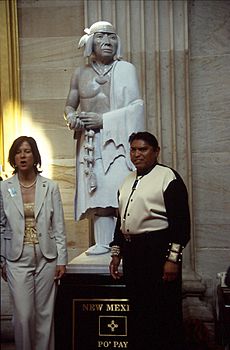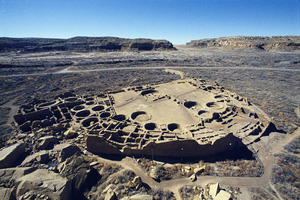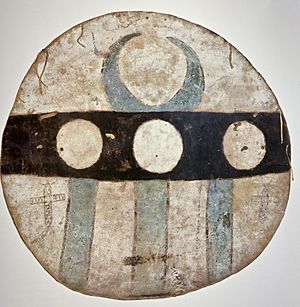History of the Puebloans facts for kids
The Puebloans are groups of Native American people who live in the southwestern United States. They are descendants of different ancient peoples who settled in the area. Their culture was also shaped by the arrival of Spanish explorers like Juan de Oñate in the late 1500s.
Three main ancient cultures contributed to the Puebloan way of life: the Mogollon, Hohokam, and Ancestral Puebloan peoples. These groups built amazing structures and developed rich cultures long before Europeans arrived. After the Spanish came, the Puebloans bravely revolted in 1680. Today, Puebloan culture is still very important in the Southwest.

Contents
Ancient Cultures of the Southwest
Puebloan societies have roots in three major cultures that lived in the Southwest United States before Europeans arrived. These were the Mogollon, Hohokam, and Ancestral Puebloan cultures. Each group had unique ways of life and building styles.
Mogollon People and Their Homes
The Mogollon culture lived near the Gila Wilderness. Archaeologists think these people first hunted and gathered food. Later, they started farming more, which became their main way to get food. They built ways to control water for farming, especially between the 900s and 1100s.
Early Mogollon villages were small. They had houses called pithouses, which were dug into the ground. These houses had roofs made of sticks, thatch, and earth. Over time, villages grew bigger. By the 1000s, houses were often built above ground using rock and earth walls. Later, in the 1200s and 1300s, some Mogollon people began living in cliff dwellings.
Hohokam: Masters of Irrigation
The word "Hohokam" comes from the O'odham language. It describes an ancient culture that was very skilled at farming. They used complex irrigation canals to water their crops, starting as early as the 800s. Their smart farming helped them become the biggest group in the Southwest by the 1200s.
Archaeologists found evidence that the ancestors of the Hohokam might have lived in southern Arizona as early as 2000 BCE. This early group grew corn and lived in settled villages year-round. They developed their advanced irrigation systems from the beginning of the Common Era until about the mid-1400s. The Hohokam culture was also a central trading hub. They traded with other groups like the Patayan, Trincheras, Mogollon, and Ancestral Puebloans.
Ancestral Puebloans and Cliff Dwellings
The Ancestral Puebloan culture is famous for its amazing stone and earth homes. These homes were often built right into the sides of cliffs. Many of these impressive structures were built between about 900 and 1350 CE. You can see some of the best-preserved examples in national parks today. These include places like Mesa Verde National Park and Chaco Culture National Historical Park.
These cliff villages were often hard to reach. People might have used ropes or climbed rocks to get to them. However, the first Ancestral Puebloan homes were pithouses, similar to those of the Basketmaker culture. Over time, they built apartment-like complexes and structures. These were made from stone, adobe mud, and other local materials. Some were carved directly into canyon walls. The designs of these villages show influences from cultures as far away as present-day Mexico.
These ancient towns were often many stories tall. They had lots of rooms and were built around open plazas. Hundreds or even thousands of Ancestral Pueblo people lived in them. These large communities were centers for cultural events and supported a wide area with their transportation routes.
Pueblo Architecture and Village Life
Around 700 to 900 CE, the Puebloans started changing their building styles. They moved away from pit houses and began building connected, rectangular rooms. These rooms were arranged like apartments and made of adobe. By 1050, they were building planned villages with large, terraced buildings, each having many rooms.
These apartment-style villages were often built in places that were easy to defend. They were located on rock ledges, flat mountaintops, or steep-sided mesas. These locations helped protect the Puebloans from raiding groups coming from the north, like the Comanche and Navajo. One of the largest villages was Pueblo Bonito in Chaco Canyon, New Mexico. It had about 700 rooms and five stories, possibly housing up to 1000 people.
Pueblo buildings are complex, apartment-like structures with many rooms. They were often built in smart defensive spots. The most advanced villages were large pueblos built on top of mesas, which are flat-topped hills common in the Southwest.
Spanish Arrival and Cultural Clash
Before 1598, Spanish explorers only made small visits to the Pueblo areas. Then, a group of colonizers led by Juan de Oñate arrived in the late 1500s. Their main goal was to convert the Native peoples to Catholicism.
At first, contact was peaceful. However, Spain tried to force the Puebloans to give up their traditional religion and accept Catholicism. This became more and more aggressive. The Puebloans resisted strongly because their government was led by a cacique. This leader was important for both spiritual and daily life. Over the years, the Spanish became harsher, leading to several Puebloan revolts.
The Great Pueblo Revolt
The Pueblo Revolt began in 1680. It was the first time a Native American group successfully forced colonists out of North America for a long period. This revolt followed an earlier conflict in 1540-41, the Tiguex War, which had temporarily stopped Spanish advances. The 1680 revolt happened because the Northern Pueblos were increasingly unhappy with the Spanish. This unhappiness finally led to a large, organized uprising.
Problems leading to the revolt began at least ten years before it started. In the 1670s, a severe drought hit the region. This caused a famine for the Pueblo people and led to more raids by the Apache. Neither Spanish nor Pueblo soldiers could stop these Apache attacks.
The tension among the Pueblos reached a peak in 1675. Governor Juan Francisco Treviño ordered the arrest of 47 Pueblo medicine men. He accused them of practicing sorcery. Four of these medicine men were sentenced to death. Three were killed, and one died in prison. The others were publicly whipped and sent to prison.
When Pueblo leaders heard about the killings and public humiliation, they marched to Santa Fe, where the prisoners were held. Many Spanish soldiers were away fighting the Apache, so Governor Treviño had to release the prisoners. One of the released prisoners was an Ohkay Owingeh Tewa man named Popé.
After his release, Popé went to Taos Pueblo, far from Santa Fe. For the next five years, he worked to gain support for a revolt among the 46 Pueblo villages. He successfully got the support of many groups, including the Northern Tiwa, Tewa, Towa, Tano, and Keres-speaking Pueblos of the Rio Grande Valley. The Pecos Pueblo, the Zuni, and the Hopi also joined the revolt. At that time, there were only about 2,400 Spanish colonists, including mixed-blood people and Native American servants, spread thinly across the region.
Starting on August 10, 1680, Popé and other Pueblo leaders sent a knotted rope by runner to each village. The number of knots showed how many days to wait before starting the uprising. Finally, on August 21, 2,500 Pueblo warriors attacked Santa Fe. They took control of the capital from the Spanish. Many colonists were killed, and the rest were forced to leave.
On September 22, 2005, a statue of Po'pay (Popé), the leader of the Pueblo Revolt, was unveiled in the Capitol Rotunda in Washington, D.C. This statue was the second one New Mexico commissioned for National Statuary Hall. It was the 100th and last statue added to the collection, which represents the Senate. The statue was created by Cliff Fragua, a Puebloan from Jemez Pueblo, New Mexico. It is the only statue in the collection made by a Native American artist.



